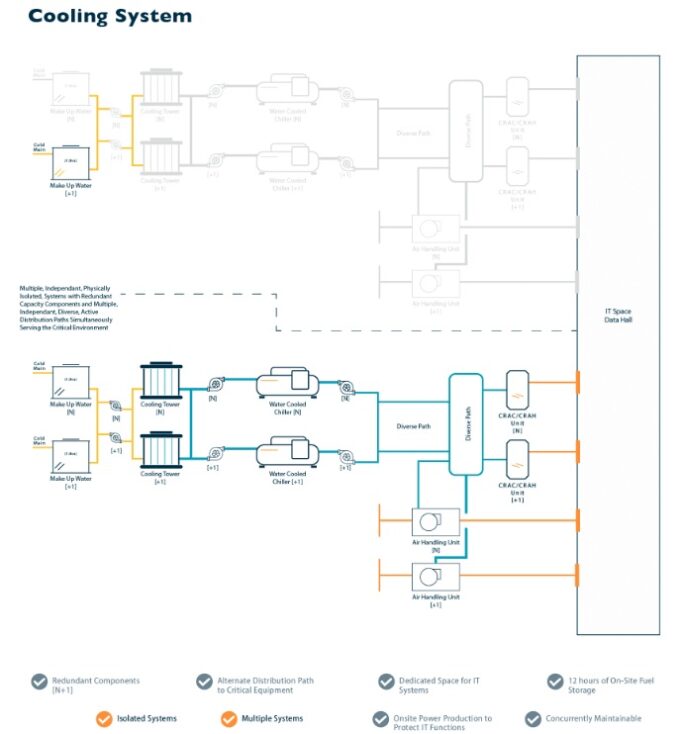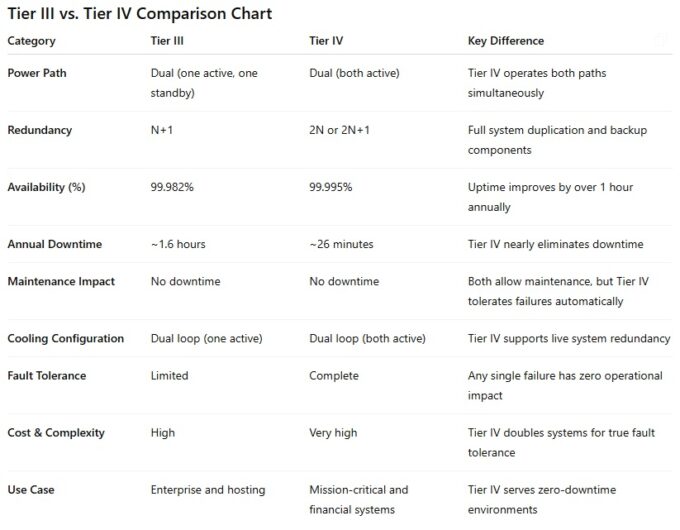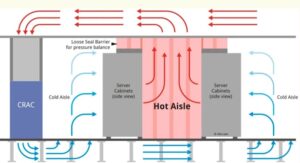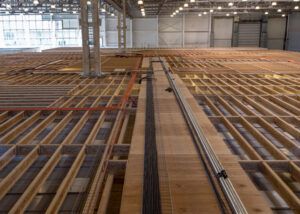Tier IV Data Center Design Considerations for Architecture, Structural, and MEP Disciplines
Tier IV data centers represent the highest level of resilience, performance, and operational integrity. They are designed for fault tolerance, meaning any single failure—mechanical, electrical, or structural—has no impact on IT operations.
This level of design supports industries requiring continuous, around-the-clock availability, such as financial institutions, healthcare systems, and cloud service providers.
Understanding Tier IV Data Centers
Tier IV facilities include multiple active power and cooling distribution paths, fully independent and concurrently maintainable.
Each system is 2N or 2N+1 redundant, meaning there are two complete, independent systems plus one backup component.
Tier IV data centers deliver 99.995% availability, or roughly 26 minutes of downtime per year.
Every component—power, cooling, and connectivity—is isolated, monitored, and capable of continuous operation even during equipment failure, maintenance, or natural disaster.
Architectural Design Considerations
Architectural design for Tier IV prioritizes system segregation, secure circulation, and fail-safe zoning.
Lay out the building with physically separated electrical and mechanical rooms, each serving an independent power or cooling path.
Provide redundant utility entrances for power, fiber, and water supply—located in different fire and flood zones.
Design dual equipment galleries, generator yards, and fuel systems with distinct containment areas.
Interior layouts must maintain clear physical separation between A and B system routes for electrical, chilled water, and data cabling.
Incorporate robust building envelopes, fire-rated construction, and blast-resistant walls where applicable.
Ensure secure access zones and redundant ingress/egress routes for staff safety and maintenance flexibility.
Use durable, cleanable finishes to support high-reliability environments with minimal contamination risk.

Structural Design Considerations
Structural systems in Tier IV facilities must provide maximum strength, vibration control, and survivability.
Design floor systems for 250 psf or higher in IT and mechanical areas to accommodate redundant equipment.
Provide seismic separation joints to protect independent systems and maintain structural integrity during seismic events.
Include redundant equipment support structures, ensuring each path remains operational after localized damage.
Integrate independent cable and piping chases within structural framing to maintain physical isolation.
Use fireproofing and compartmentalization strategies to contain failures or hazards within limited zones.
Design the structure for long-term adaptability, allowing modular expansions or upgrades without service interruption.
MEP Design Considerations
Electrical Systems
Tier IV electrical systems are fully fault-tolerant, using dual active power paths (A and B) that both operate simultaneously.
Each path includes independent generators, UPS units, switchgear, and PDUs.
Power paths must never intersect physically or share single points of failure.
Each IT rack connects to dual power feeds, each capable of carrying the full load.
Integrate Automatic Transfer Switches (ATS) and Static Transfer Switches (STS) to instantly reroute power during failures.
Designers should employ 2N or 2N+1 redundancy across every major component.
Include sophisticated Energy Management Systems (EMS) and real-time monitoring for power quality, load balancing, and predictive maintenance.
Backup fuel storage should provide at least 96 hours of continuous runtime, with refueling redundancy from multiple access points.

Mechanical Systems
Mechanical design must support fault-tolerant cooling with multiple active distribution loops.
Use dual chilled-water or DX systems, each serving 100% of the IT load independently.
Include isolated piping networks, each with separate pumps, chillers, and CRAC/CRAH units.
Deploy automated isolation valves and cross-connect points to reroute flow during maintenance or system failure.
Implement 2N+1 redundancy in critical cooling components to ensure continuous operation even during multiple concurrent failures.
Employ containment systems (hot-aisle/cold-aisle or in-row cooling) for maximum thermal control.
All equipment should connect to an advanced Building Management System (BMS) capable of real-time control, monitoring, and fault detection.
Airflow, temperature, and humidity must remain within ASHRAE-recommended envelopes under all conditions.

Designing for the Future
Tier IV facilities represent the pinnacle of reliability but also demand disciplined maintenance, operation, and energy management.
Future-proofing involves modular redundancy—allowing system replacement, expansion, or migration without downtime.
Designers should prioritize scalability, sustainability, and energy efficiency through strategies like free cooling, high-efficiency UPS systems, and renewable integration.

Conclusion
Tier IV data centers embody continuous availability and operational fault tolerance.
Architects must ensure physical segregation and secure zoning, structural engineers must support redundant systems and hazard resistance, and MEP teams must deliver fully independent infrastructure paths.
When executed correctly, Tier IV facilities provide the highest assurance of uptime and operational continuity available in modern data center design.











